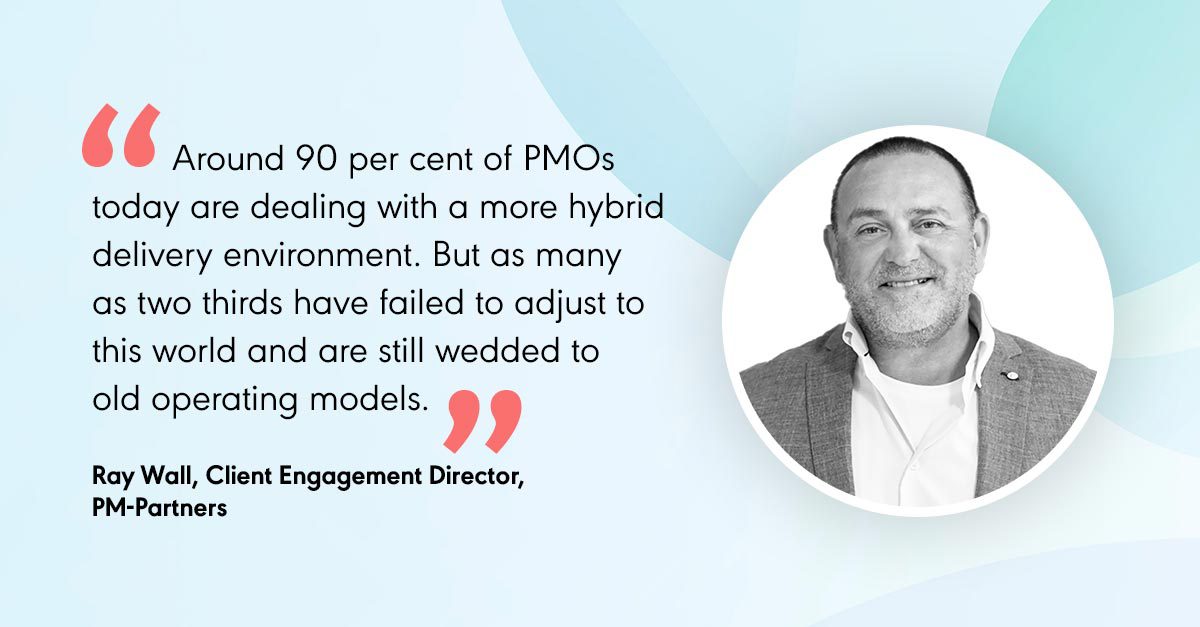6 ways to transition to a hybrid PMO model

Most PMOs today are operating in a hybrid world of project delivery while also managing expanded delivery pipelines and rising complexity. So, how can you transition to a more hybrid PMO model and what are the key factors for success? This was the topic of a recent webinar jointly led by PM-Partners Client Engagement Director Ray Wall – here he summarises some of the insights he shared, and his responses to questions raised during the event.
Based on PM-Partners research and engagements, around 90 per cent of organisations today – be this IT groups or broader PMOs – are dealing with a more hybrid delivery environment. But despite the need to cater for a mix of agile and traditional methods, as many as two thirds have failed to adjust to this world and are still wedded to old operating models.
Today’s PMOs are also faced with what we call ‘the dynamic factors’. Chief among these is a massive increase in project throughput, particularly initiatives related to ‘data’ or ‘digitisation’, as organisations look to make up for a lack of investment during the pandemic. Then there are the usual suspects, such as compliance, market disruption and intense competition.
Faced with a ‘catch-up’ mindset, new ways of working and ongoing complexity, it’s no wonder that PMOs that remain stuck in the past are feeling the pressure (or embroiled in chaos). Fortunately, there are some simple steps you can take to start reshaping your PMO into one that can face up to today’s challenges and proactively facilitate the delivery of value across teams.
6 steps to a dynamic, hybrid PMO model
1. Redefine your purpose and intent
In conjunction with executives and practitioners, you need to reconsider the what, why, how, and who of your PMO. In other words:
- What are you doing? This includes the type or types of agile you’re using – you need to be very clear on your methods upfront and how you may be adapting them to suit your environment. Likewise, what metrics will you use and what criteria will you refer to when selecting the execution approach for each project?
- Why are you doing it? Consider the vision, the objectives and expected benefits of moving to these new ways of working, and how you’ll measure progress. It may sound like a given but we often see organisations moving to new ways of working without properly thinking through why they’re pursuing that route.
- How are you doing it? This includes the approach you’re using to either introduce the new ways of working or uplift your current state if you’re already dealing with a mix of delivery methods. Again, this needs to be measurable.
- Who are you doing it with? When you make a change to the way you’re working in today’s PMO sphere, it’s critical that you have all three levels of the organisation with you on the journey. You need to have your executives briefed and understand their vision, objectives and desires, you need to bring the business with you, and you need to bring the practitioners from both the traditional and agile sides. It’s an unfortunate truth, but if you miss one group you’ll fail.
2. Develop a comprehensive plan
Planning is crucial but can unfortunately fall to the wayside when you’re in a rush. If you’re going to introduce agile or uplift your approach, you need to treat this exercise like a project. In other words, it needs change management; it needs measures, resources, governance and reporting – a detailed plan that includes all critical aspects is a must.
3. Communicate, communicate and communicate again
The old adage is you need to tell people at least three times before it sinks in and it’s our view that you can’t over-communicate these things. One of the easiest ways to ensure failure is to take shortcuts with change management and communication. So don’t fall into this trap and try to initiate changes independently.
4. Bring in the right expertise
A key factor for PMOs struggling to adjust to new models is that their collective expertise fails to reflect the makeup of their delivery portfolios. Let’s say half of your portfolio is agile and half is waterfall. Then 50 per cent of the people in your PMO need to be seasoned agile practitioners – either people with a track record in agile delivery or those who have successfully introduced agile. These agile veterans will effectively be the translator between the agile and traditional worlds.
5. Avoid silos ‘the turf wars’ at all costs
The right expertise will help in this regard as all too frequently we see walls build up over time between different types of practitioners. There’s the traditional/waterfall world typically considered the old dinosaurs, and the younger, fresher agile world and ‘never the twain shall meet’. Of course, this two tribes scenario will only make a PMO’s job harder so it can’t be allowed to play out. All impacted parties need to be constantly told that the organisation supports both – and reminded that the organisation decides how a project is delivered, not the practitioners. PMOs should develop triage capability to assist this process.
6. Review and revise, regularly
PMOs should be revisiting their operating models at least twice a year, or whenever there’s a significant change across the business. This is critical to ensure they remain aligned to the executives’ vision and the objectives of the organisation. Likewise, you need to review the standards, measures and metrics you have in place, along with the tools you need to support them, to make sure you’ve got consistent processes and approaches across the board. Without them people will make up their own. Inconsistency kills is the key message here!
Your questions answered
Following the webinar, Ray responded to a number of questions which address some common stumbling blocks around successfully navigating the transition to a hybrid model.
Q1. How do you align EPM vs PMO governance?
There are various ways to achieve this, but the relevant targets and metrics (containing both lead and lag indicators) must first be defined and agreed between the PMO and the executive team. A workshop series is potentially the most practical way to get the basics completed initially. The following resources provide more context and ideas that may be of help:
Q2. How can you develop rapport and trust in teams under hybrid work arrangements?
One of the best ways to develop trust among your teams is to be clear about what is expected from each group and regularly measure performance against the agreed standards. If possible, make the exercise of measuring team performance and outcomes a job that the various teams self-manage and self-rate.
To build this trust even further, you can have teams jointly develop their performance standards, measures and metrics with key personnel from the PMO and senior executives who oversee PMO and delivery team performance. The following article provides some further context:
Q3. What do executives most want to see and how do you build strong relationships with them?
Executives want delivery outcomes in a predictable and cost-effective manner. They usually have very busy day jobs and it’s important to understand the amount of time they can provide for PMO or programme/project delivery matters. With this in mind, book the executives for regular sessions, perhaps as quarterly business reviews, and ensure you have agreed on how the PMO will be managed and how it will provide performance updates to the executive team.
Q4. How do you present value from the PMO function to the business and be an enabler of business goals? And how do you determine the role of the PMO?
Again, perhaps the most effective way is to ensure that you and your sponsoring executives are completely aligned in terms of the services and functions provided by the PMO. You also need to be on the same page regarding how performance will be measured and reported on.
Setting longer term performance objectives and targets can also be very effective, providing you define and agree what the baseline performance is, what the targets are, and which measures you’ll use to track progress.
Q5. How long does the transition take to a dynamic PMO model and how can you accelerate this process?
This can vary quite substantially depending on the functions and services being provided. A good rule of thumb is to use something like the Capability Maturity Model Integration (CMMI), which measures process maturity on a 5-point scale. It will typically take 12 months plus to move from, for example, level 2 to level 3. Some aspects can be accelerated, especially if you and your executives are willing to invest in, for instance, more experienced team members or tools and advice from experts.
The following articles provide further information built up over many years of dealing with PMO’s in a variety of organisations:
Keen to move your PMO from a state of chaos to one that’s in tune with our hybrid world? PM-Partners can build, refresh or re-energise your complete PMO environment to ensure it fulfils its role and delivers value irrespective of delivery approaches. Contact our experts or call 1300 70 13 14 today.

About The Author
Ray Wall
Client Engagement Director, PM-Partners
An industry leader in globally-recognised delivery methods and standards, Ray has a wealth of experience implementing effective governance frameworks and controls across diverse industries and organisations. He has a proven ability to help leaders and delivery teams achieve business agility through the design and execution of complex change and transformation.
As Client Engagement Director, Ray is responsible for the advisory and delivery teams focusing on client success. Prior to joining PM-Partners, Ray held senior positions in leading organisations including St. George Bank and Westpac Group, and spent several years optimising client delivery results as a management consultant.







